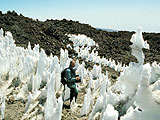 |
|
|
|
|
|
|
The subtropical volcanic archipelago off shore NW-Africa, here exemplified by the island of Tenerife, receives its moisture from the trade winds, enveloping the coniferous montane forest in clouds almost year round, leaving little precipitation for the alpine belt above. The 3700 m cone of the Teide volcano thus emerges form an alpine semi-desert, called the Cañadas. Poor in species due to its isolation and young geological age, the flora offers outstanding features such as the giant Echium rosette species, a nice example of convergence troughout the tropics and subtropics, particularly in Hawaii. |
|
1 - Cañadas - the lower alpine semi-desert is dominated by large cushion plants. |
|
|
2 - Echium wildpretii (Boraginaceae), 2-3 m tall candle shaped giant rosettes, take several years to flower and then die. |
3 - Descurainia burgeana (Brassicaceae) (Teide, 3200 m) |
|
4 - Ice sculptures on Teide at 3650 m, the home of a single species, Viola cheiranthifolia (Violaceae). |
5 - Viola cheiranthifolia (Violaceae) (Teide, 3650 m) |
|
Botanical Image Database of the University of Basel. Search for plants occurring in the Cañadas. |
29 August 2011 |
||
| |
||





